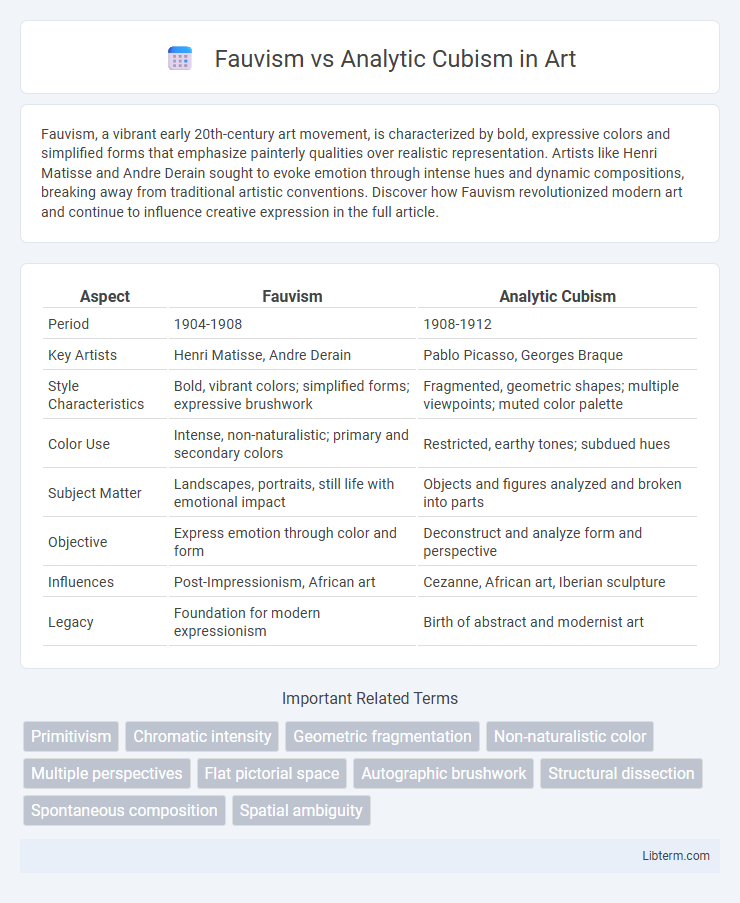Fauvism, a vibrant early 20th-century art movement, is characterized by bold, expressive colors and simplified forms that emphasize painterly qualities over realistic representation. Artists like Henri Matisse and Andre Derain sought to evoke emotion through intense hues and dynamic compositions, breaking away from traditional artistic conventions. Discover how Fauvism revolutionized modern art and continue to influence creative expression in the full article.
Table of Comparison
| Aspect | Fauvism | Analytic Cubism |
|---|---|---|
| Period | 1904-1908 | 1908-1912 |
| Key Artists | Henri Matisse, Andre Derain | Pablo Picasso, Georges Braque |
| Style Characteristics | Bold, vibrant colors; simplified forms; expressive brushwork | Fragmented, geometric shapes; multiple viewpoints; muted color palette |
| Color Use | Intense, non-naturalistic; primary and secondary colors | Restricted, earthy tones; subdued hues |
| Subject Matter | Landscapes, portraits, still life with emotional impact | Objects and figures analyzed and broken into parts |
| Objective | Express emotion through color and form | Deconstruct and analyze form and perspective |
| Influences | Post-Impressionism, African art | Cezanne, African art, Iberian sculpture |
| Legacy | Foundation for modern expressionism | Birth of abstract and modernist art |
Introduction to Fauvism and Analytic Cubism
Fauvism, emerging in the early 20th century, is characterized by vivid, non-naturalistic colors and bold brushwork that emphasize emotional expression over realistic representation. Analytic Cubism, pioneered by Pablo Picasso and Georges Braque, deconstructs objects into fragmented geometric shapes, presenting multiple viewpoints simultaneously to analyze form and structure. Both movements revolutionized modern art by challenging traditional perspectives, with Fauvism focusing on color intensity and Analytic Cubism emphasizing spatial complexity.
Historical Context and Emergence
Fauvism emerged in the early 20th century, around 1904-1908, as a reaction against Impressionism, characterized by vivid, non-naturalistic colors and bold brushwork, primarily led by Henri Matisse and Andre Derain. Analytic Cubism developed slightly later, between 1908 and 1912, pioneered by Pablo Picasso and Georges Braque, focusing on deconstructing objects into geometric shapes and multiple perspectives to depict form and space analytically. Both movements arose during a period of rapid industrialization and cultural transformation in Europe, reflecting artists' explorations of new ways to interpret reality amidst shifting societal norms.
Key Artists and Influencers
Fauvism, led by Henri Matisse and Andre Derain, emphasized bold, vibrant color and expressive brushwork, influencing modern art's shift toward abstraction. Analytic Cubism, pioneered by Pablo Picasso and Georges Braque, focused on deconstructing objects into geometric forms and multiple perspectives, shaping the development of abstract art and visual perception. Both movements significantly impacted 20th-century avant-garde art through their distinct approaches to form, color, and space.
Core Artistic Philosophies
Fauvism emphasizes bold, vibrant colors and expressive brushwork to capture emotional intensity and spontaneity, prioritizing subjective experience over realistic representation. Analytic Cubism focuses on deconstructing objects into geometric shapes and multiple perspectives to explore the underlying structure and form, promoting intellectual analysis over emotional expression. Both movements challenge traditional aesthetics but diverge in their approach: Fauvism values color and emotional impact, whereas Analytic Cubism centers on form and conceptual complexity.
Techniques and Visual Styles
Fauvism employs bold, vibrant colors and loose brushwork to emphasize emotional expression and simplified forms, rejecting naturalistic color schemes for striking, non-representational palettes. Analytic Cubism, pioneered by Picasso and Braque, deconstructs subjects into fragmented geometric shapes and multiple viewpoints, using muted earthy tones and overlapping planes to convey depth and structure analytically. Fauvism prioritizes color intensity and spontaneity, while Analytic Cubism focuses on intellectual analysis of form and space through abstracted perspectives.
Use of Color and Form
Fauvism is characterized by vivid, non-naturalistic colors applied in bold, expressive brushstrokes, emphasizing emotional intensity and spontaneity in form. Analytic Cubism dissects objects into fragmented, geometric shapes, using a muted, monochromatic palette to focus on structure and multiple perspectives simultaneously. The contrasting approaches illustrate Fauvism's reliance on color for emotional impact versus Analytic Cubism's use of form to analyze spatial relationships.
Subject Matter and Themes
Fauvism emphasizes vivid colors and simplified forms to depict natural landscapes, portraits, and still lifes, focusing on emotional expression and visual stimulation. Analytic Cubism deconstructs subjects such as figures, objects, and scenes into geometric shapes and multiple perspectives, highlighting structural complexity and abstract representation. Thematically, Fauvism explores spontaneity and sensory experience, while Analytic Cubism investigates intellectual analysis and fragmented reality.
Reception and Impact on the Art World
Fauvism, characterized by its bold use of color and expressive brushwork, initially faced mixed reactions but quickly influenced modern art by liberating color from representational constraints, inspiring movements like Expressionism. Analytic Cubism, pioneered by Picasso and Braque, received critical acclaim for its intellectual approach to form and perspective, profoundly impacting the trajectory of abstract art and paving the way for Synthetic Cubism and Futurism. Both movements challenged traditional artistic conventions, reshaping 20th-century art discourse and expanding the possibilities of visual representation.
Legacy and Lasting Influence
Fauvism's bold use of vibrant colors and emotional expression reshaped modern art by inspiring movements like Expressionism and Abstract Art. Analytic Cubism's fragmented perspectives introduced revolutionary ways of depicting form and space, profoundly impacting Futurism, Surrealism, and ultimately the development of abstract and conceptual art. Both movements fostered a departure from traditional representation, laying foundational principles for 20th-century avant-garde experimentation.
Comparative Analysis: Fauvism vs Analytic Cubism
Fauvism, characterized by vivid, non-naturalistic colors and bold brushstrokes, emphasizes emotional expression and spontaneity, while Analytic Cubism, pioneered by Picasso and Braque, deconstructs subjects into geometric shapes and multiple perspectives for intellectual analysis. Fauvist artworks like Henri Matisse's "Woman with a Hat" showcase vibrant color palettes and simplified forms, contrasting with the muted tones and fragmented planes of Analytic Cubism exemplified by Picasso's "Les Demoiselles d'Avignon." Both movements revolutionized early 20th-century art by challenging traditional representation but diverged in method and conceptual focus--Fauvism through color-driven expressiveness, Analytic Cubism through structural dissection and abstraction.
Fauvism Infographic

 libterm.com
libterm.com